2. 南开大学环境污染过程与基准教育部重点实验室, 天津 300071
2. Key Laboratory of Pollution Processes and Environmental Criteria, Ministry of Education, Nankai University, Tianjin 300071, China
持久性有机污染物理化性质稳定,难以降解,能长期存在于水、土壤等各种环境介质中,并能随之长距离迁移,且具有很强的毒性,能够沿食物链逐步积累,对人类健康会造成严重的危害,现在已经成为一个备受关注的全球性环境问题. 多环芳烃(polycyclic aromatic hydrocarbons,PAHs)和有机氯农药(organochlorine pesticides,OCPs)是两类典型的持久性有机污染物. PAHs是由2个或多个芳香环连接形成、超过10 000种单个化合物组成的一类复杂混合物[1],在环境中广泛存在,主要通过石油类产品的泄漏及排放、干湿沉降、地表径流及污水排放等方式进入湖泊、河流等水体[2~4],水环境中的PAHs对水生生物可产生潜在危害,可以影响无脊椎动物、鱼类和两栖类等水生生物的生殖系统发育,并可能产生致癌、致畸和致突变现象[5~7],进而对人类健康构成极大威胁. 正是因为PAHs具有高毒性、致畸、致突变和致癌等特性,16种PAHs已被美国EPA和欧盟列为优先控制污染物[8]. OCPs具有难降解性、生物富集性、半挥发性和高毒性等特性,可通过各种途径在全球迁移[9],有研究表明一些OCPs还被认为是内分泌干扰物,能够造成人体和野生动物内分泌系统紊乱和影响生殖系统的正常功能[10, 11]. 自20世纪50年代起,OCPs曾在世界范围内被广泛使用,由于其具有持久性,至今仍广泛存在于各环境介质中,依旧能够在水体、土壤、空气、鱼类、甚至食品中检测到其存在[12, 13],虽然在20世纪80年代起六六六(hexachlorocyclohexanes,HCHs)、滴滴涕(dichlorodiphenyltrichloroethanes,DDTs)等OCPs已经被禁用,但是三氯杀螨醇、林丹等OCPs在最近十几年还在农业活动等特定范围内广泛应用[14, 15],直到2014年中国才永久性关闭最后一条三氯杀螨醇生产线,全面停止三氯杀螨醇的生产. OCPs可通过地表径流、工业废水排放、大气干湿沉降或远距离传输等途径进入河流、湖泊等水体中[16, 17],对水生生物和人类健康构成严重危害. 有关湖泊、河流水体、沉积物、悬浮颗粒物等环境介质中PAHs和OCPs污染一直受到国内外学者的极大关注并成为世界范围内的研究热点,且开展了广泛的研究[18~20].
白洋淀是华北地区最大的淡水湖泊,由143个大小淀泊和3 700多条壕沟组成,总面积366 km2,其中水面占44%、陆地占56%. 有潴龙河、唐河、漕河、瀑河、府河、萍河、白沟河等河流入淀. 白洋淀素有“华北明珠”、“北国江南”之称,是华北地区最大的一块湿地,已被列入中国重要湿地名录. 白洋淀在拦洪蓄水、调节气候、改善生态环境等方面发挥了重要作用. 近年来,随着经济的快速发展和人口的不断增加,白洋淀水质状况逐渐恶化. 目前,白洋淀淀区及周边分布有39个村庄,约243 000人口居住,每天产生大量的生活污水; 另外,来自白洋淀上游保定市的大量生活污水和工业废水经府河直接入淀[21],对白洋淀水体造成极大污染.
研究白洋淀PAHs、OCPs等持久性有机污染物的环境存在,是评估其对水生生物、人类和水生态系统的风险,并采取有效控制策略的基础. 自90年代以来,针对白洋淀PAHs、OCPs等持久性有机污染物的分布与污染特征,已经有广泛深入的研究,特别是针对白洋淀地区沉积物/底泥[22, 23]、土壤[24]、鱼体[25, 26]等环境介质中PAHs和OCPs的组成与分布特征多有报道,为掌握白洋淀持久性有机污染物污染状况积累了大量数据资料. 目前,关于白洋淀地表水环境中OCPs污染状况已有相关研究[21, 27],但至今仍缺少白洋淀水体中多环芳烃污染状况的相关资料,同时,近十几年来白洋淀水体环境状况也发生了很大变化. 因此,为有效评价海河流域重要湖泊——白洋淀的持久性有机污染物的污染现状,识别人类活动对白洋淀水质状况的影响,评估持久性有机污染物对人类和生态系统的风险,亟需掌握白洋淀水体PAHs和OCPs的污染特征及来源. 本文通过监测白洋淀表层水体中17种PAHs和15种OCPs的组成、分布及浓度,分析白洋淀水体中持久性有机污染物的季节性污染特征及来源,以期为白洋淀持久性有机污染物有效控制提供科学依据和技术支撑.
1 材料与方法 1.1 监测断面布设和样品采集结合白洋淀自身实际情况,共布设12个能代表白洋淀水质状况的监测断面,分别是:留通、王家寨、郭里口、枣林庄、光淀张庄、安新桥、大张庄、圈头、采蒲台、前塘、端村、关城,各监测断面位置如图 1所示. 样品分别采集于2015年的春季和夏季,时间分别是5月9~11日和8月27~28日,各采样点取表层(0.5 m)水样1 L,用棕色玻璃瓶保存并带回实验室分析测定.
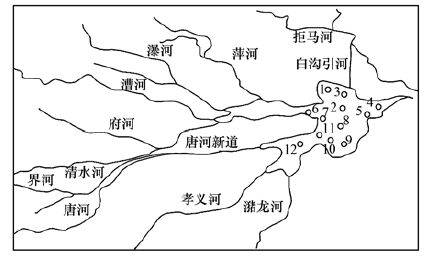
|
1.留通; 2.王家寨; 3.郭里口; 4.枣林庄; 5.光淀张庄; 6.安新桥; 7.大张庄; 8.圈头; 9.采蒲台; 10.前塘; 11.端村; 12.关城 图 1 白洋淀各采样断面示意 Fig. 1 Sampling sites of Baiyangdian Lake |
Agilent 7890A/7000B气相色谱-三重串联四级杆质谱(Agilent公司,美国); 全自动固相萃取仪(GL Science公司,日本); Bond Elut C18固相萃取小柱(500 mg/6mL,Agilent公司).
17种PAHs标准样品,包括:萘(Naphthalene,Nap)、苊(Acenaphthene,AcP)、苊烯(Acenaphthylene,Acy)、芴(Fluorene,FL)、菲(Phenanthrene,Phe)、蒽(Anthracene,Ant)、咔唑(Carbazole,Car)、荧蒽(Fluoranthene,Flu)、芘(Pyrene,Pyr)、苯并[a]蒽[Benz(a)anthracene,BaA]、(Chrysene,Chr)、苯并[b]荧蒽[Benz(b)fluoranthene,BbFL]、苯并[k]荧蒽[Benz(k)fluoranthene,BkFL]、苯并[a]苝[Benzo(a)pyrene,BaP]、茚并[1,2,3-cd]芘[Indeno(1,2,3,-cd)pyrene,InP]、苯并(g,h,i)芘[Benzo(g,h,i)pylene,BghiP]、二苯并(a,h)蒽[Drbenz(a,h)anbhracene,DBA],购自美国Accustandard公司.
15种OCPs标准样品,包括8种OCPs混标,包含:α-六氯环己烷(α-HCH)、β-六氯环己烷(β-HCH)、林丹(γ-HCH)、δ-六氯环己烷(δ-HCH)、 p,p′-滴滴伊(p,p′-DDE)、 p,p′-滴滴滴(p,p′-DDD)、o,p′-滴滴涕(o,p′-DDT)和p,p′-滴滴涕(p,p′-DDT),购自环境保护部标准样品研究所; 7种OCPs单标:七氯(Heptachlor)、环氧七氯(Heptachlor epoxide)、艾氏剂(Aldrin)、狄氏剂(Dieldrin)、异狄氏剂(Isodrin)、α-硫丹(α-Endosulfan)、β-硫丹(β-Endosulfan),购自农业部环境保护科研监测所.
色谱纯乙酸乙酯和二氯甲烷,购自韩国Duksan公司; 色谱纯甲醇,购自美国Baker公司.
1.3 水体中多环芳烃与有机氯农药的测定 1.3.1 前处理条件使用Bond Elut C18固相萃取小柱对水样进行富集. 取水样1 000 mL,按V(水样)∶V(甲醇)=100∶1加入甲醇,混合均匀; 将固相萃取小柱置于全自动固相萃取仪上,经5 mL流速为3 mL·min-1的二氯甲烷和乙酸乙酯洗涤、10 mL流速为5 mL·min-1的甲醇和高纯水活化后,将水样以15 mL·min-1流速通过小柱,富集完成后干燥固相萃取柱,再用2 mL乙酸乙酯、2 mL二氯甲烷和2 mL二氯甲烷,分别以1、1和2 mL·min-1的流速依次洗脱小柱,合并收集洗脱液. 经干燥浓缩后,用二氯甲烷定容至1 mL,摇匀后,上机分析.
1.3.2 气相色谱-质谱条件气相色谱条件:HP-5MS毛细管柱(30m×0.25mm×0.25μm); 传输线温度:280℃; 载气:高纯氦气(>99.999%),柱流量:1.2 mL·min-1; 进样压力80.6 kPa(11.681 psi,恒压模式); 进样模式:不分流进样; 进样体积1 μL.
PAHs检测升温程序为:80℃保持1 min,以20℃·min-1升至250℃,再以10 ℃·min-1升至300℃,保持5.5 min,总分析时间为20 min; 进样口温度:270℃.
OCPs监测升温程序为:80℃保持1 min,以20℃·min-1升至230℃,保持6 min,总分析时间为14.5 min; 进样口温度:270℃.
质谱条件:EI源,能量70 eV,温度230℃; 四极杆温度:150℃; 碰撞气为高纯氮气; 参数优化方式为SCAN模式和productor模式; 检测方式为MRM模式.
1.3.3 质量控制和质量保证样品分析过程中参考USEPA和《水环境监测规范》(SL 219-2013)中QA/QC要求,通过方法空白、空白加标、样品加标、样品平行样等方法保证监测结果质量. 本研究水样中OCPs回收率范围为70.30%~115.10%,相对标准偏差(RSD)为0.60%~12.20%; 检出限范围为0.08~0.38 ng·L-1. PAHs回收率69.80%~111.60%之间,相对标准偏差(RSD)为4.90%~12.60%; 检出限范围为0.10~0.25 ng·L-1. 样品进样后利用Agilent 7890A/7000B气相色谱-三重串联四级杆质谱的Mass Hunter数据采集软件对17种PAHs和15种OCPs进行定量分析.
1.4 数据处理采用SPSS 17.0统计软件进行数据分析.
2 结果与讨论 2.1 白洋淀水体PAHs的季节性污染特征及来源分析 2.1.1 白洋淀不同季节水体PAHs浓度白洋淀春、夏两季表层水体中17种PAHs浓度分析结果如表 1所示. 从中可以看出,白洋淀春季表层水体中PAHs总浓度范围是35.38~88.06 ng·L-1,平均值为46.57 ng·L-1; 夏季表层水体中PAHs总浓度范围是25.64~301.41 ng·L-1,平均值为76.23 ng·L-1. 17种PAHs中,春季除BaP、InP、BghiP和DBA未检出外,其他13种全部检出,检出浓度较高的两种PAHs依次是Phe和Nap,分别占总浓度的24.85%和17.67%,可见Phe对白洋淀春季表层水体中PAHs总浓度贡献最大; 夏季除BghiP未检出外,其他16种全部检出,检出浓度较高的两种PAHs依次是Nap和Phe,分别占总浓度的68.39%和11.60%,可见Nap对白洋淀夏季表层水体中PAHs总浓度贡献最大.
|
|
表 1 白洋淀表层水体中PAHs污染状况1)/ng·L-1 Table 1 Concentrations of polycyclic aromatic hydrocarbons in experimental water body of Baiyangdian Lake/ng·L-1 |
分析白洋淀各监测断面表层水体中PAHs季节性污染差异,各监测断面春、夏两季表层水体中17种PAHs总浓度如图 2所示. 从中可以看出,由于前塘、关城和安新桥夏季表层水体中Nap浓度分别高达273.98、134.19和131.85 ng·L-1,造成这3个断面夏季PAHs总浓度要远高于春季PAHs总浓度,其他9个断面则均表现为春季PAHs总浓度普遍略高于夏季PAHs总浓度,且差异显著(P<0.05).
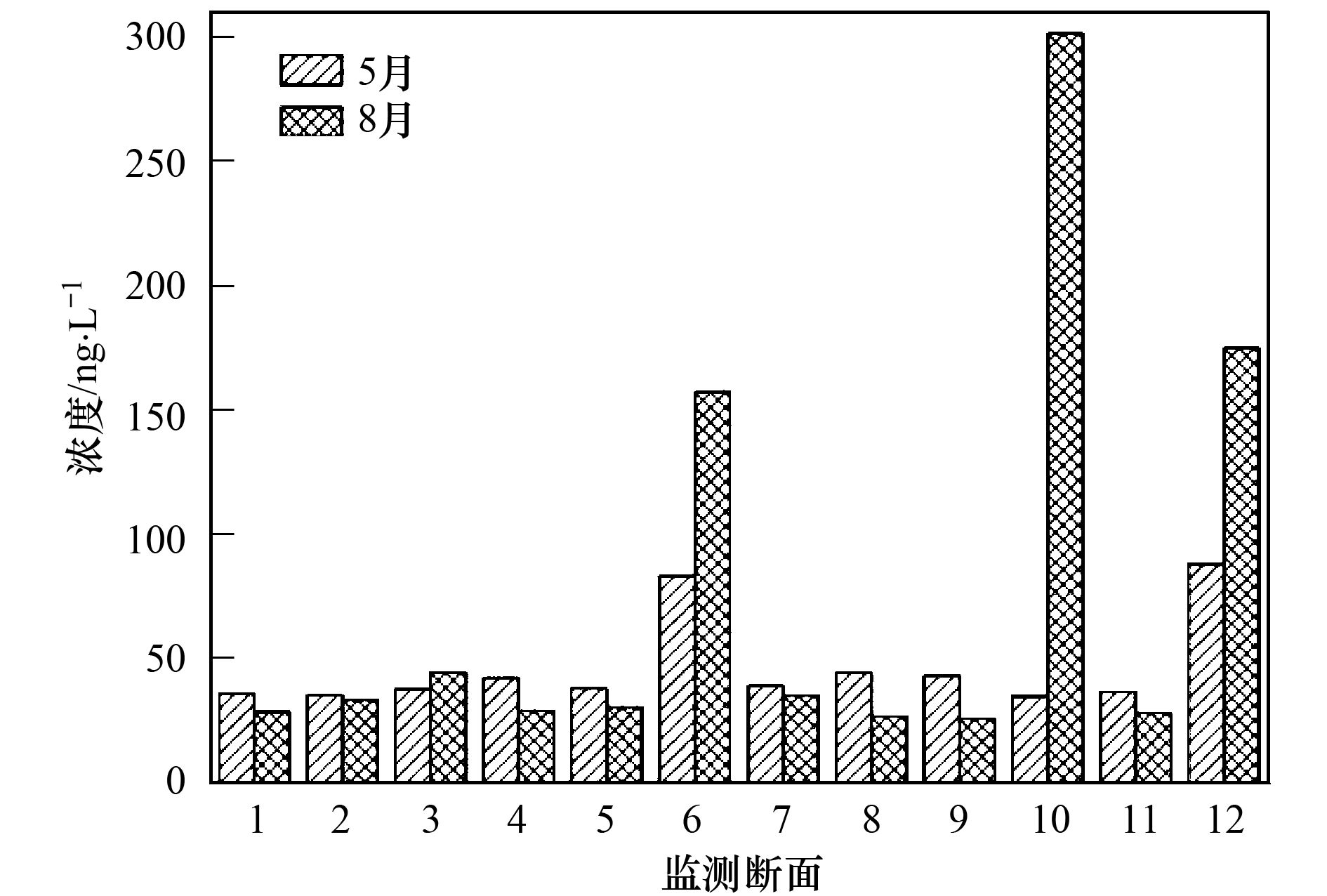
|
图 2 白洋淀各断面水体中PAHs总浓度 Fig. 2 Concentrations of total PAHs in surface water of Baiyangdian Lake |
在研究水环境中PAHs浓度季节性变化过程中,根据低环数PAHs在水-气界面的交换作用,一般春季低环数PAHs浓度以及PAHs总浓度均要低于其夏季浓度,主要原因是由于Nap等低环数PAHs具有较高的蒸气压,且春季温度较低,大气中以气态形式存在的低环数PAHs通过水-气交换大量进入水体中,导致水体中低环数PAHs浓度升高[28~30]; 另外,夏季强光照作用造成的PAHs光降解也能导致夏季PAHs浓度比春季浓度要低[30]. 上述可能是构成白洋淀大部分监测断面表层水体春季PAHs总浓度要普遍略高于夏季PAHs总浓度的主要原因. 安新桥、前塘和关城等3个断面的PAHs季节性污染特征同北京市枯水和丰水季水源水体中PAHs分布特征[31]、以及西江水体中PAHs的季节分布特征[32]相似,而其表层水体中夏季PAHs总浓度要远高于春季PAHs总浓度,其中Nap是主要贡献因子,可能原因是这3个断面夏季表层水体中有特定污染源汇入. Nap通常用作石油类物质泄漏的指示物[33, 34],尤其是前塘和关城这两个断面靠近周边村庄,作为华北平原最大的湖泊湿地和重要景区,夏季正处于旅游旺季,淀区居民的日常生活、交通运输及渔船、游船等活动更加频繁,在此过程中煤柴燃烧、作物焚烧、船舶燃油泄漏等产生大量的PAHs进入水体; 安新桥断面所在位置处于白洋淀上游主要河流府河的入淀处,河道两侧是人口相对稠密的安新县县城,来自县城及上游保定市的大量生活污水和工业废水未经处理直接通过府河进入淀区,由此带来大量的PAHs污染.
2.1.2 白洋淀不同季节水体PAHs组成特征白洋淀春、夏两季表层水体中17种PAHs污染组成特征如图 3所示. 从白洋淀春、夏两季表层水体17种PAHs组成上看,春季主要以三环芳烃为主,其次是四环和二环,占PAHs总浓度的比例分别为45.92%~61.36%(平均为52.60%)、19.79%~32.18%(平均为24.61%)和17.31%~26.11%(平均为21.09%),王家寨断面三环芳烃所占比例最高,达到61.36%; 与春季PAHs组成比例相比,夏季二环芳烃比例增加还是由于安新桥、前塘和关城等3个监测断面二环芳烃Nap浓度高造成,分别占PAHs总浓度的比例为84.91%、91.04%和78.10%,而其他9个监测断面主要以三环芳烃为主,占PAHs总浓度的比例为37.14%~53.90%(平均为48.94%),二环和四环芳烃分别占PAHs总浓度比例为21.90%~48.45%(平均为30.55%)和16.30%~24.65%(平均为18.96%); 白洋淀春、夏两季表层水体中其他各环芳烃浓度均不超过PAHs总浓度2%.
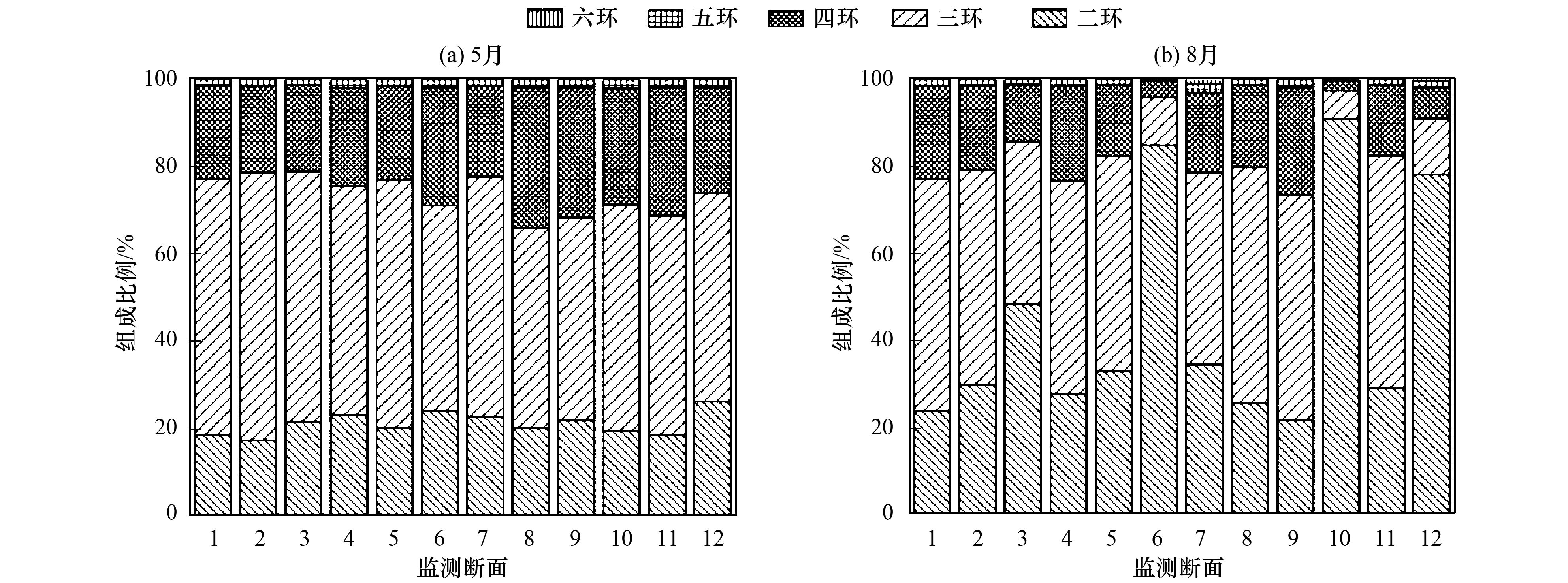
|
图 3 白洋淀各断面水体中PAHs组成比例 Fig. 3 Compositions of PAHs with different ring numbers in surface water of Baiyangdian Lake |
总体来看,白洋淀春、夏两季表层水体中PAHs的组成均以中低环芳烃为主,一方面取决于PAHs的辛醇-水分配系数,高分子量的PAHs疏水性更强,更易于向沉积物和颗粒物相分配; 另一方面与污染源有关,有研究表明4环及以上的PAHs主要来源于化石燃料高温燃烧与裂解,而低分子量(2~3环)的PAHs则主要来源于石油类产品和化石燃料不完全燃烧或成岩作用[35, 36].
2.1.3 白洋淀不同季节水体PAHs来源分析PAHs主要来源于自然因素和人为因素,自然因素主要包括森林和草原的天然火灾以及火山喷发、高等植物和微生物的合成以及成岩作用; 人为因素主要包括燃烧源和石油源,燃烧源包含煤、石油等化石燃料、生物燃料等的不完全燃烧、机动车尾气的排放,以及人类工业活动等,石油源包含石油开采、运输、生产、使用过程的泄漏与排放[37, 38].
不同来源的PAHs有特定的组成特征,其同分异构体比值常用于指示PAHs在环境介质中的来源[38, 39]. 由于Ant、Phe、Flu、Pyr、BaA、Chr等PAHs具有相对稳定的特性,Ant/(Phe+Ant)、 Flu/(Pyr+Flu)和BaA/(BaA+Chr)的比值被广泛用于PAHs来源分析[39]. 通常认为当Ant/(Phe+Ant)比值小于0.1时,表示PAHs主要来自于石油源,大于0.1表示主要为燃烧源,Baumard等[40]研究发现,在机动车尾气排放和原油、柴油、煤炭、焦炉、木材燃烧过程产生的物质中Ant/(Phe+Ant)比值均大于0.1; 当Flu/(Flu+Pyr)比值小于0.4时,表示其主要来源为石油源,介于0.4和0.5之间为液态石油类产品(汽油、煤油、原油等)的燃烧,大于0.5为煤和草、木材等生物燃料的燃烧; 当BaA/(BaA+Chr)比值小于0.2时,表示其主要来源为石油源,大于0.35为燃烧源,介于0.2和0.35之间为混合源[39, 40].
分别计算白洋淀春、夏两季表层水体中Ant/(Phe+Ant)、 Flu/(Pyr+Flu)和BaA/(BaA+Chr)比值,以Ant/(Phe+Ant)为X轴,Flu/(Pyr+Flu)为Y轴,BaA/(BaA+Chr)为Z轴作PAHs来源诊断图,结果如图 4所示. 从中可以看出,在白洋淀春季表层水体中,所有监测断面Ant/(Phe+Ant)比值均大于0.1,Flu/(Pyr+Flu)比值在枣林庄和前塘小于0.4,在端村介于0.4和0.5之间,其他监测断面均大于0.5,所有断面BaA/(BaA+Chr)比值均介于0.2和0.35之间; 在白洋淀夏季表层水体中,所有监测断面Ant/(Phe+Ant)比值均大于0.1,Flu/(Pyr+Flu)比值在枣林庄小于0.4,在王家寨、光淀张庄和端村介于0.4和0.5之间,其他监测断面均大于0.5,BaA/(BaA+Chr)比值小于0.2的断面有大张庄、留通、圈头和采蒲台,其他断面均介于0.2~0.35之间. 可见从PAHs同分异构体比值来看,白洋淀表层水体中PAHs主要来源于燃烧源,部分监测断面还存在石油源,并且在春夏两季无明显差别. 该诊断结果与白洋淀实际情况相符,淀区内村庄和人口众多,每天产生大量的生活污水,还有居民日常生活中的煤炭、木柴等燃料的燃烧,以及交通运输及捕鱼、旅游等活动过程中机动船舶所需柴油、汽油等油料的燃烧、泄漏及含油污水排放和尾气排放; 同时,来自白洋淀上游保定市的生活污水和工业废水也大量排入淀内,上述原因构成白洋淀表层水体PAHs的主要来源.
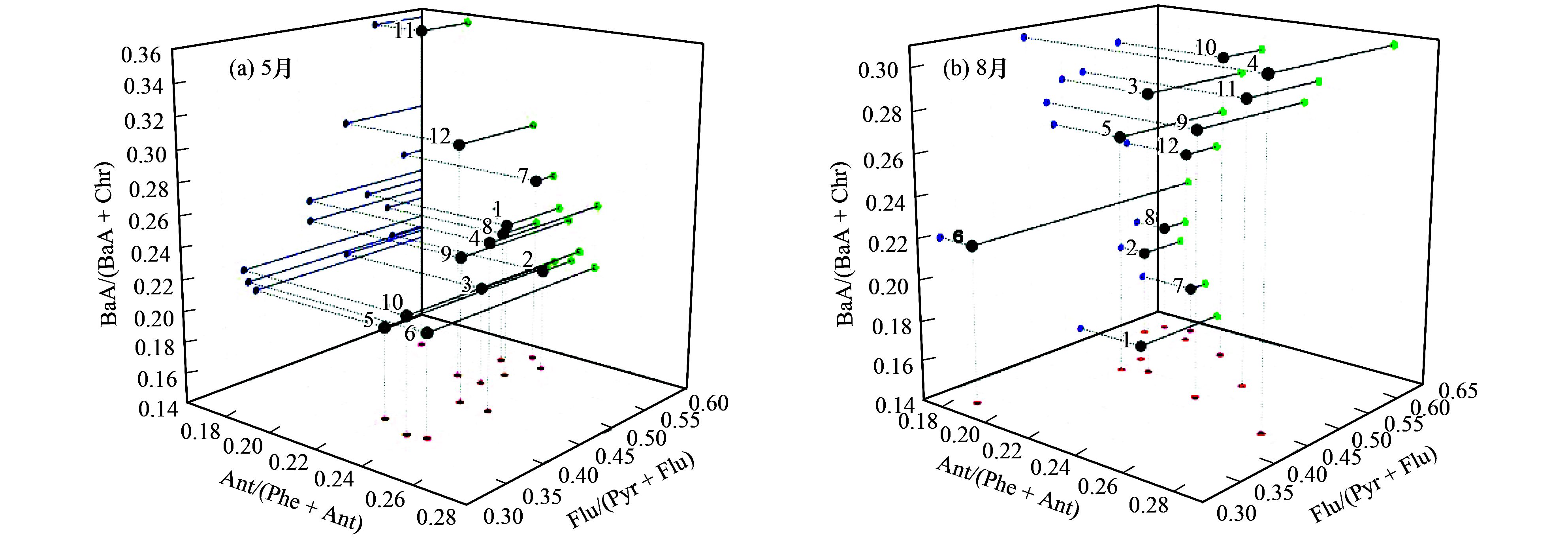
|
图 4 白洋淀春、夏两季水体中PAHs来源诊断三维图 Fig. 4 Plots of PAHs isomer pair ratios for source identification in surface water of Baiyangdian Lake in spring and summer |
PAHs水质标准是反映其在水体中污染水平的重要指示. 表 2是中国地表水环境质量标准[42]、美国环保署颁布的国家水质标准[43]、欧盟水框架指令[44]和加拿大环境质量准则[45]中规定的PAHs浓度限值. 从中可以看出,白洋淀春、夏两季表层水体PAHs浓度均不超过上述标准规定的限值.
|
|
表 2 不同国家或组织PAHs水质标准1)/ng·L-1 Table 2 Standards for water quality of PAHs developed by different countries or organizations /ng·L-1 |
由于PAHs脂溶性强,水体中的PAHs可通过食物链在生物体内富集放大,再通过鱼类及贝类被人类食用而进入人类体内,对人类健康构成威胁. 一些国家和国际组织通过可获得的大量毒理学数据及一系列外推方法制定了水生生物暴露于PAHs污染水体的安全标准[46](如表 3),安全标准中的数据指示的是水生生物,尤其是贻贝和牡蛎等滤食软体动物生物累积水体中相应浓度的PAHs,通过食物链进而能够对人类健康构成威胁的PAHs浓度. 参考国际上不同国家的安全标准,由表 3可知,白洋淀春、夏两季表层水体中各单体PAHs均未超过各国制定的安全标准,但PAHs总浓度超过了美国环境质量标准的规定限值.
|
|
表 3 水生生物暴露PAHs水体的安全标准1)/μg·L-1 Table 3 Safety guidelines for aquatic organisms exposed to PAHs in water/μg·L-1 |
表 4是白洋淀及国内外其他湖泊水体中PAHs的污染状况比较. 由于白洋淀夏季安新桥、前塘和关城等3个监测断面存在特定污染源,因此春季监测数据更能反映白洋淀整体污染状况. 从中可以看出,与国内部分重要湖泊水体PAHs污染状况相比,白洋淀水体PAHs污染水平与小白洋淀相当,远低于西湖、太湖、巢湖、鄱阳湖和滴水湖,其中西湖水体PAHs浓度约为白洋淀水体PAHs浓度的30~60倍,太湖和巢湖水体PAHs浓度约为白洋淀水体PAHs浓度的3~4倍; 与国外部分湖泊水体PAHs相比,白洋淀PAHs污染水平要远高于阿尔卑斯山脉的GGossenkölle湖、比利牛斯山的Redó湖、苏格兰的 Øver Neådalsvatn湖、意大利的Maggiore湖和南非的Zeekoevlei湖,低于英国的Esthwaite湖、埃及的Great Bitter和El Temsah湖、斯里兰卡的Beira湖和Bolgoda湖、肯尼亚的Victoria湖,其中白洋淀水体PAHs浓度要比GGossenkölle湖、Redó湖等湖泊水体PAHs浓度高1~2个数量级,比Great Bitter、El Temsah湖、Victoria湖等湖泊水体PAHs浓度低3个数量级.
|
|
表 4 白洋淀及国内外其他湖泊水体PAHs污染状况1)/ng·L-1 Table 4 Concentrations of PAHs in surface water of other lakes in China and abroad for comparison/ng·L-1 |
2.2 白洋淀水体15种有机氯农药的季节性污染特征及来源分析 2.2.1 白洋淀不同季节水体OCPs浓度
白洋淀春、夏两季表层水体中15种OCPs污染浓度分析结果如表 5所示. 从中可以看出,白洋淀春、夏两季表层水体中只有HCHs和DDTs有不同程度检出,其他几种OCPs均未检出. 其中,春季有4种HCHs和2种DDTs被检出,HCHs占OCPs总浓度的94.83%,DDTs占OCPs总浓度的5.17%; 夏季只有3种HCHs被检出,占OCPs总浓度的100%. 可见白洋淀春、夏两季表层水体的OCPs污染主要以HCHs为主,其他OCPs的贡献很小.
|
|
表 5 白洋淀表层水体OCPs污染状况1)/ng·L-1 Table 5 Concentrations of organochlorine pesticides in surface water of Baiyangdian Lake/ng·L-1 |
从季节变化上看,白洋淀春、夏两季表层水体中OCPs总浓度呈现显著差异(P<0.05),总体表现为春季OCPs总浓度高于夏季OCPs总浓度. 从表 5中可见,春季表层水体中OCPs总浓度范围是0.69~4.50 ng·L-1,平均值为1.77 ng·L-1; 夏季表层水体中OCPs总浓度范围是0.11~3.20 ng·L-1,平均值为0.90 ng·L-1. 由图 5可见,除关城断面春季OCPs总浓度低于夏季OCPs总浓度外,其他监测断面春季OCPs总浓度普遍要高于夏季OCPs总浓度. OCPs总浓度最高值和最低值分别出现在春季(5月)和夏季(8月),分别为4.50 ng·L-1和0.11 ng·L-1,断面分别是端村和王家寨.
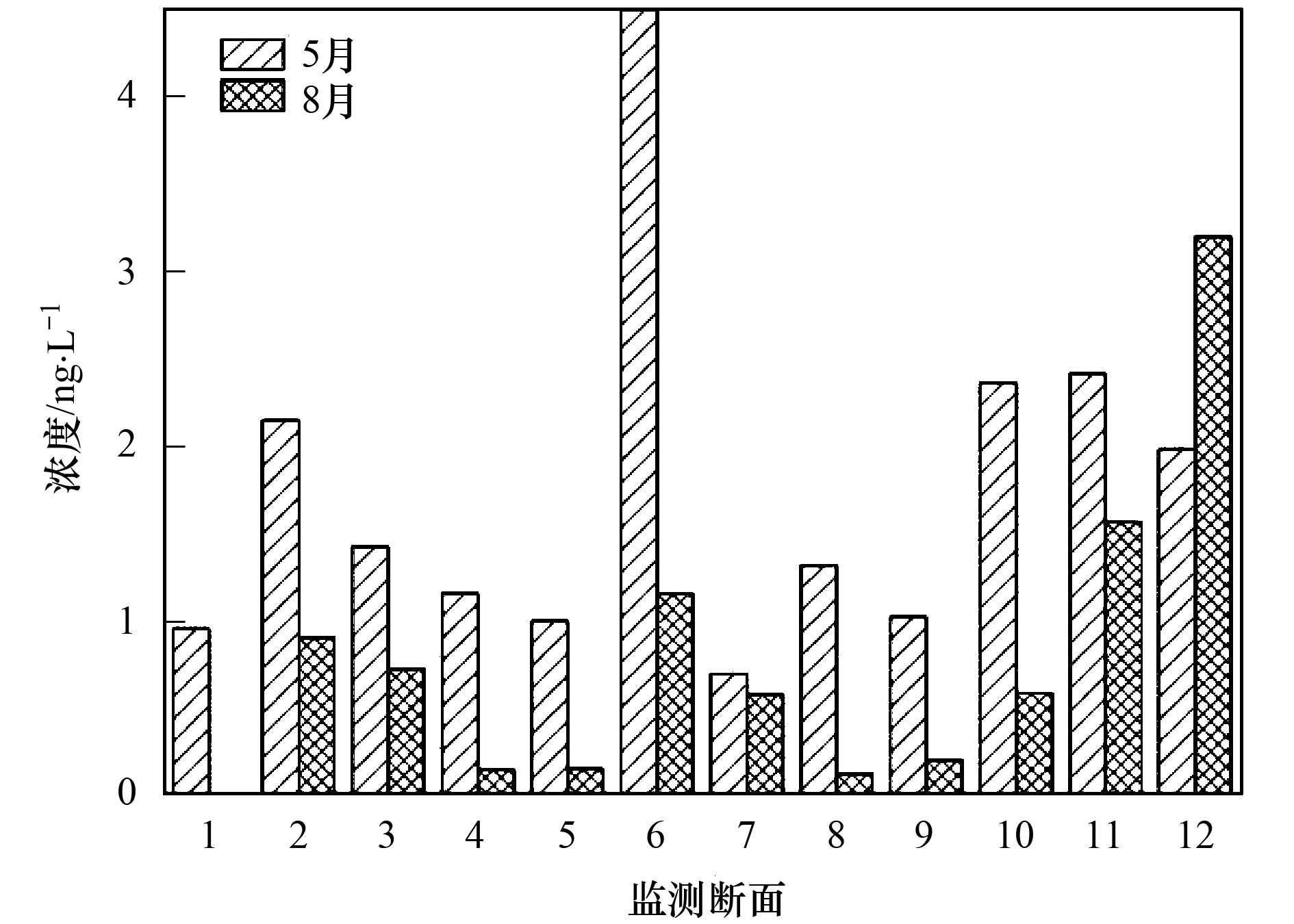
|
图 5 白洋淀各断面水体中OCPs总浓度 Fig. 5 Concentrations of total OCPs in surface water of Baiyangdian Lake |
在研究水环境中OCPs浓度季节性变化过程中,一般在径流量较大的丰水期,水流对土壤的侵蚀作用加强,土壤残留的OCPs随农田地表径流进入水体,使丰水期表层水体中OCPs浓度升高,因此很多研究表明OCPs污染呈现面源污染的特征[62~64]. 白洋淀春季和夏季分别为枯水期和丰水期,大部分监测断面表层水体OCPs浓度变化却表现为春季高于夏季,即枯水期高于丰水期,只有关城断面OCPs浓度变化表现为夏季高于春季,可见白洋淀表层水体中OCPs污染并没有呈现面源污染特征,分析原因可能是丰水期上游来水和生态调水对淀区水体的稀释作用; 夏季采样期间关城断面水体浑浊,其OCPs总浓度比春季高可能是由于表层沉积物的再悬浮造成.
2.2.2 白洋淀不同季节水体OCPs组成特征根据上述分析,从白洋淀春、夏两季表层水体中15种OCPs的检出情况来看主要以HCHs为主,因此本研究主要分析白洋淀春、夏两季表层水体中HCHs污染组成特征.
白洋淀春、夏两季表层水体HCHs组成特征如图 6所示. 从中可以看出,春季各监测断面表层水体HCHs以β-HCH为主,占HCHs总浓度的29.94%~100%,平均比例为59.87%; 夏季各监测断面表层水体中,大张庄、郭里口、王家寨、前塘、安新桥等5个监测断面表层水体HCHs以β-HCH为主,占HCHs总浓度的57.55%~80.23%,平均比例为61.98%,枣林庄、光淀张庄、圈头、采蒲台这4个断面均只检测到α-HCH,端村和关城断面表层水体以δ-HCH为主,分别占HCHs总浓度的50.20%和85.96%. 水体中HCHs以β-HCH为主的原因主要取决于β-HCH的自身结构,其物理性质相对于其他HCHs组分更为稳定,水溶性和挥发性较低,是最不容易被降解的HCH异构体.
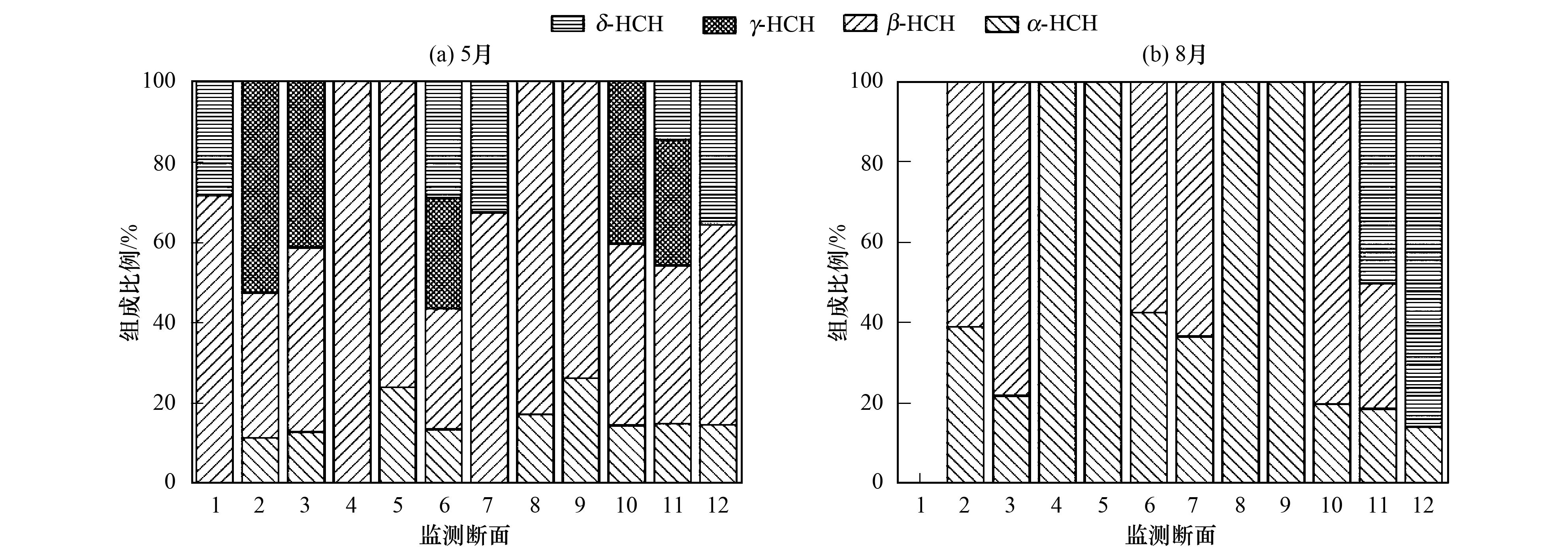
|
图 6 白洋淀各断面水体中HCHs组成比例 Fig. 6 Compositions of HCHs in surface water of Baiyangdian Lake |
环境中的HCHs主要来自于杀虫剂的使用,工业品HCHs和林丹是HCHs的两种来源已得到广泛认同和普遍接受,其中,工业品HCHs各同分异构体所占的比例分别是:α-HCH占55%~80%; β-HCH占5%~14%; γ-HCH占8%~15%; δ-HCH占2%~16%; 其他占3%~5%[65],以及林丹中包含99%以上的γ-HCH[66]. 通常用α-HCH与γ-HCH的浓度比值来判别HCHs的来源,一般情况下在工业品HCHs中该比值的范围为3~7,但是当有林丹或γ-HCH输入时,该比值可能接近或小于1; 如果该比值高于7,可能原因是HCHs的长距离传输或者工业品HCHs在环境中的反复循环和降解,这是因为α-HCH比γ-HCH的半衰期长约25%[67]. 另外,在大气的长距离传输过程中,γ-HCH在光化学作用下可转化为α-HCH,这也可能使α-HCH与γ-HCH的浓度比值高于7[67, 68]. 白洋淀春、夏两季各监测断面表层水体α-HCH/γ-HCH比值如表 6所示,从中可见,白洋淀春、夏两季大部分监测断面表层水体中α-HCH/γ-HCH比值要大于7,表明白洋淀表层水体中HCHs主要来源于环境残留和大气的长距离传输. 另外,春季王家寨、郭里口、安新桥、前塘和端村等5个断面α-HCH/γ-HCH比值小于1,表明在春季这几个断面可能有新的林丹或γ-HCH输入.
|
|
表 6 白洋淀春夏两季表层水体α-HCH/γ-HCH比值 1) Table 6 Ratios of α-HCH/γ-HCH in surface water of Baiyangdian Lake in spring and summer |
工业品DDTs一般包含77.1% p,p′-DDT,14.9% o,p′-DDT,4% p,p′-DDE[69]. 自然界中DDT能够在不同环境条件下转化为不同的产物,一般在有氧条件下转化为DDE,而在厌氧条件下转化为DDD[70]. 通常用DDT/DDE的值来预估DDT的使用年限[71]. 一般在禁用DDT后,随着DDT降解为DDE和DDD,DDT浓度与DDE、DDD浓度之和的比值应小于1,如果该比值大于1,则说明有新源输入[66, 72]. 本研究中白洋淀表层水体只有在春季检出p,p′-DDE和p,p′-DDD两种DDTs,说明DDTs污染是来源于环境中的残留.
2.2.4 白洋淀表层水体OCPs污染水平表 7是中国地表水环境质量标准[42]、美国环保署颁布的国家水质标准[43]、欧盟水框架指令[44]和加拿大环境质量准则[45]中规定的部分OCPs浓度限值. 从中可以看出,白洋淀春、夏两季表层水体OCPs浓度均远低于上述标准规定的限值.
|
|
表 7 不同国家或组织OCPs水质标准1)/μg·L-1 Table 7 Standards for water quality of OCPs provided by different countries or organizations/μg·L-1 |
环境水质基准是制定水体环境质量标准限值的基础,对于预测、评价、控制和治理进入水环境中的污染物质,维护良好生态环境具有重要意义. 如表 8所示,根据毒理学数据和数值计算,美国环保署制定了OCPs人体健康水质基准和水生生物水质基准,其中,人体健康水质基准代表的是通过饮水和食用水生生物或只通过食用水生生物而对人类不产生有害影响的污染物最大可接受浓度; 水生生物基准代表的是水体中特定污染物预计不会对大多数物种构成重大风险的最低浓度,包括急性毒性值和慢性毒性值. 参考美国环保署OCPs人体健康水质基准和水生生物水质基准,从中可见,春、夏两季中安新桥断面表层水体中α-HCH浓度均超过人体健康水质基准,夏季中圈头断面表层水体中p,p′-DDD浓度超过了人体健康水质基准,α-HCH、 p,p′-DDD通过食物链被富集于鱼类、贝类等水生生物体内,进而通过饮水、皮肤接触、食用鱼类或贝类等途径进入人体内,对白洋淀这两个断面所属淀区居民健康会产生潜在有害影响.
|
|
表 8 美国环保署OCPs人体健康水质基准和水生生物水质基准 1)/μg·L-1 Table 8 Human health ambient water quality criteria and aquatic life criteria by EPA/μg·L-1 |
表 9是白洋淀及国内外其他湖泊水体中OCPs的污染状况比较. 从中可以看出,白洋淀水体OCPs污染水平与白洋淀历史水平相比要低,表明白洋淀表层水体OCPs污染状况相对于历史状况有所好转; 与国内其他重要湖泊水体OCPs污染状况相比,白洋淀水体OCPs污染水平与太湖相当,低于西湖、微山湖、巢湖、鄱阳湖、百花湖、官厅水库和千岛湖,要远远低于洱海和滇池中OCPs污染水平,其中,西湖水体OCPs浓度约为白洋淀水体OCPs浓度的26倍,洱海和滇池水体中OCPs浓度要比白洋淀水体OCPs浓度高1~2个数量级; 与国外部分湖泊水体OCPs相比,白洋淀OCPs污染水平与加纳的Bosomtwi湖相当,要低于伊朗的Tashk湖、加纳的Volta湖、希腊的Volvi湖、Vistonida湖、Vegoritida湖、L. Prespa湖和S. Prespa湖,其浓度相差1~2个数量级.
|
|
表 9 白洋淀及国内外其他湖泊水体OCPs污染状况1)/μg·L-1 Table 9 Concentrations of OCPs in surface water of other lakes in China and abroad for comparison/μg·L-1 |
3 结论
(1) 白洋淀春、夏两季表层水体中PAHs季节性污染特征表现为前塘、关城和安新桥等3个断面夏季PAHs总浓度要远高于春季PAHs总浓度,分析原因可能是存在特定污染源汇入,而其他9个断面则均表现为春季PAHs总浓度略高于夏季PAHs总浓度,其中,白洋淀春季表层水体中PAHs总浓度范围是35.38~88.06 ng·L-1,平均值为46.57 ng·L-1,夏季表层水体中PAHs总浓度范围是25.64~301.41 ng·L-1,平均值为76.23 ng·L-1. 从PAHs组成特征来看,白洋淀春、夏两季表层水体中不同环数PAHs组成比例差异明显,春季主要以三环芳烃为主,其次是四环和二环; 与春季PAHs组成比例相比,夏季二环芳烃比例明显增加是由于安新桥、前塘和关城等3个监测断面二环芳烃Nap浓度高造成,而其他9个监测断面主要以三环芳烃为主,其次是二环和四环芳烃. PAHs同分异构体比值显示白洋淀春、夏两季表层水体中PAHs主要来源于燃烧源,部分监测断面还存在石油源. 同国内部分湖泊PAHs污染水平相比,白洋淀春、夏两季表层水体中PAHs污染水平要低,而与国外部分湖泊水体中PAHs污染水平相比白洋淀污染水平要高,但浓度不超过不同国家和组织制定的地表水水质标准和水生生物安全标准.
(2) 白洋淀春、夏两季表层水体中OCPs季节性污染特征总体表现为关城断面夏季OCPs总浓度高于春季OCPs总浓度,分析原因可能是由于表层沉积物的再悬浮,其他11个监测断面均表现为春季OCPs总浓度高于夏季OCPs总浓度,其中,白洋淀春季表层水体中OCPs总浓度范围是0.69~4.50 ng·L-1,平均值为1.77 ng·L-1; 夏季表层水体中OCPs总浓度范围是0.11~3.20 ng·L-1,平均值为0.90 ng·L-1. 从OCPs组成特征来看,白洋淀春、夏两季表层水体中OCPs只有HCHs和DDTs有不同程度检出,且呈现出以HCHs为主的污染特征,其中,春季各监测断面表层水体中HCHs均以β-HCH为主,而夏季大张庄、郭里口、王家寨、前塘、安新桥等5个监测断面表层水体中HCHs以β-HCH为主,占HCHs总浓度的57.55%~80.23%,平均比例为61.98%,其他断面以α-HCH和δ-HCH为主. OCPs同分异构体比值显示白洋淀春、夏两季表层水体中OCPs主要来源于环境残留和大气的长距离传输,同时春季王家寨、郭里口、安新桥、前塘和端村等5个断面还可能有新的林丹或γ-HCH输入. 同国内外部分湖泊OCPs污染水平相比,白洋淀春、夏两季表层水体中OCPs污染水平均要偏低,其浓度不超过不同国家和组织制定的地表水水质标准,但安新桥和圈头两个监测断面表层水体中α-HCH、 p,p′-DDD 浓度超过了美国环保署制定的人体健康水质基准,表明α-HCH、 p,p′-DDD可能会对白洋淀淀区居民健康产生潜在有害影响.
| [1] | Logan D T. Perspective on ecotoxicology of PAHs to fish[J]. Human and Ecological Risk Assessment:An International Journal, 2007, 13(2) : 302–316. DOI: 10.1080/10807030701226749 |
| [2] | Eganhouse R P, Simoneit B R T, Kaplan I R. Extractable organic matter in urban storm water runoff. 2. Molecular characterization[J]. Environmental Science & Technology, 1981, 15(3) : 315–326. |
| [3] | Dickut R M, Gustafson K E. Atmospheric inputs of selected polycyclic aromatic hydrocarbons and polychlorinated biphenyls to Southern Chesapeake Bay[J]. Marine Pollution Bulletin, 1995, 30(6) : 385–396. DOI: 10.1016/0025-326X(94)00196-G |
| [4] | Heemken O P, Stachel B, Theobald N, et al. Temporal variability of organic micropollutants in suspended particulate matter of the River Elbe at Hamburg and the River Mulde at Dessau, Germany[J]. Archives of Environmental Contamination and Toxicology, 2000, 38(1) : 11–31. DOI: 10.1007/s002449910003 |
| [5] | Skarphéðinsdóttir H, Ericson G, Svavarsson J, et al. DNA adducts and polycyclic aromatic hydrocarbon (PAH) tissue levels in blue mussels (Mytilus spp.) from Nordic coastal sites[J]. Marine Environmental Research, 2007, 64(4) : 479–491. DOI: 10.1016/j.marenvres.2007.03.007 |
| [6] | Engraff M, Solere C, Smith K E C, et al. Aquatic toxicity of PAHs and PAH mixtures at saturation to benthic amphipods:linking toxic effects to chemical activity[J]. Aquatic Toxicology, 2011, 102(3-4) : 142–149. DOI: 10.1016/j.aquatox.2011.01.009 |
| [7] | 郭广慧, 吴丰昌, 何宏平, 等. 中国地表水体多环芳烃含量分布特征及其生态风险评价[J]. 中国科学D辑:地球科学, 2012, 55(6) : 914–925. Guo G H, Wu F C, He H P, et al. Distribution characteristics and ecological risk assessment of PAHs in surface waters of China[J]. Science China Earth Sciences, 2012, 55(6) : 914–925. DOI: 10.1007/s11430-012-4434-z |
| [8] | Manoli E, Samara C, Konstantinou I, et al. Polycyclic aromatic hydrocarbons in the bulk precipitation and surface waters of Northern Greece[J]. Chemosphere, 2000, 41(12) : 1845–1855. DOI: 10.1016/S0045-6535(00)00134-X |
| [9] | Shete A, Gunale V R, Pandit G G. Organochlorine pesticides in Avicennia marina from the Mumbai mangroves, India[J]. Chemosphere, 2009, 76(11) : 1483–1485. DOI: 10.1016/j.chemosphere.2009.06.055 |
| [10] | Briz V, Molina-Molina J M, Sánchez-Redondo S, et al. Differential estrogenic effects of the persistent organochlorine pesticides dieldrin, endosulfan, and lindane in primary neuronal cultures[J]. Toxicological Sciences, 2011, 120(2) : 413–427. DOI: 10.1093/toxsci/kfr019 |
| [11] | Xue N D, Wang H B, Xu X B. Progress in study on endocrine disrupting pesticides (EDPs) in aquatic environment[J]. Chinese Science Bulletin, 2005, 50(20) : 2257–2266. DOI: 10.1007/BF03183731 |
| [12] | Tanabe S, Iwata H, Tatsukawa R. Global contamination by persistent organochlorines and their ecotoxicological impact on marine mammals[J]. Science of the Total Environment, 1994, 154(2-3) : 163–177. DOI: 10.1016/0048-9697(94)90086-8 |
| [13] | Wu C F, Luo Y M, Gui T, et al. Concentrations and potential health hazards of organochlorine pesticides in shallow groundwater of Taihu Lake region, China[J]. Science of the Total Environment, 2014, 470-471 : 1047–1055. DOI: 10.1016/j.scitotenv.2013.10.056 |
| [14] | Li Y F, Cai D J, Shan Z J, et al. Gridded usage inventories of technical hexachlorocyclohexane and lindane for China with 1/6° latitude by 1/4° longitude resolution[J]. Archives of Environmental Contamination and Toxicology, 2001, 41(3) : 261–266. DOI: 10.1007/s002440010247 |
| [15] | Li J, Zhan G, Qi S H, et al. Concentrations, enantiomeric compositions, and sources of HCH, DDT and chlordane in soils from the Pearl River Delta, South China[J]. Science of the Total Environment, 2006, 372(1) : 215–224. DOI: 10.1016/j.scitotenv.2006.09.023 |
| [16] | Doong R A, Sun Y C, Liao P L, et al. Distribution and fate of organochlorine pesticide residues in sediments from the selected rivers in Taiwan[J]. Chemosphere, 2002, 48(2) : 237–246. DOI: 10.1016/S0045-6535(02)00066-8 |
| [17] | Feng J L, Zhai M X, Liu Q, et al. Residues of organochlorine pesticides (OCPs) in upper reach of the Huaihe River, East China[J]. Ecotoxicology and Environmental Safety, 2011, 74(8) : 2252–2259. DOI: 10.1016/j.ecoenv.2011.08.001 |
| [18] | Kafilzadeh F. Distribution and sources of polycyclic aromatic hydrocarbons in water and sediments of the Soltan Abad River, Iran[J]. The Egyptian Journal of Aquatic Research, 2015, 41(3) : 227–231. DOI: 10.1016/j.ejar.2015.06.004 |
| [19] | Zheng B H, Wang L P, Lei K, et al. Distribution and ecological risk assessment of polycyclic aromatic hydrocarbons in water, suspended particulate matter and sediment from Daliao River estuary and the adjacent area, China[J]. Chemosphere, 2016, 149 : 91–100. DOI: 10.1016/j.chemosphere.2016.01.039 |
| [20] | Eremina N, Paschke A, Mazlova E A, et al. Distribution of polychlorinated biphenyls, phthalic acid esters, polycyclic aromatic hydrocarbons and organochlorine substances in the Moscow River, Russia[J]. Environmental Pollution, 2016, 210 : 409–418. DOI: 10.1016/j.envpol.2015.11.034 |
| [21] | Dai G H, Liu X H, Liang G, et al. Distribution of organochlorine pesticides (OCPs) and poly chlorinated biphenyls (PCBs) in surface water and sediments from Baiyangdian Lake in North China[J]. Journal of Environmental Sciences, 2011, 23(10) : 1640–1649. DOI: 10.1016/S1001-0742(10)60633-X |
| [22] | 窦薇, 赵忠宪. 白洋淀水体、底泥及鲫鱼体内DDT、BHC污染状况研究[J]. 环境科学学报, 1998, 18(3) : 308–312. Dou W, Zhao Z X. Contamination of DDT and BHC in water, sediments and fish (Carassius auratus) muscle from Baiyangdian lake[J]. Acta Scientiae Circumstantiae, 1998, 18(3) : 308–312. |
| [23] | Hu G C, Luo X J, Li F C, et al. Organochlorine compounds and polycyclic aromatic hydrocarbons in surface sediment from Baiyangdian Lake, North China:concentrations, sources profiles and potential risk[J]. Journal of Environmental Sciences, 2010, 22(2) : 176–183. DOI: 10.1016/S1001-0742(09)60090-5 |
| [24] | 赵健, 周怀东, 陆瑾, 等. 白洋淀土壤中多环芳烃的分布特征及来源[J]. 生态学杂志, 2009, 28(5) : 901–906. Zhao J, Zhou H D, Lu J, et al. Distribution and source of polycyclic aromatic hydrocarbons (PAHs) in soils of Baiyangdian area[J]. Chinese Journal of Ecology, 2009, 28(5) : 901–906. |
| [25] | 窦薇, 赵忠宪. 白洋淀几种不同食性鱼类对六六六、DDT的富集[J]. 环境科学进展, 1996, 4(6) : 51–56. Dou W, Zhao Z X. A study on bioaccumulation of BHC and DDT in fish muscles of different food structure from Baiyangdian lake[J]. Advances in Environmental Science, 1996, 4(6) : 51–56. |
| [26] | Xu F L, Wu W J, Wang J J, et al. Residual levels and health risk of polycyclic aromatic hydrocarbons in freshwater fishes from Lake Small Bai-Yang-Dian, Northern China[J]. Ecological Modelling, 2011, 222(2) : 275–286. DOI: 10.1016/j.ecolmodel.2010.10.001 |
| [27] | 王怡中, 刘季昂, 胡春, 等. 白洋淀地区水中有机污染物的定性分析[J]. 环境化学, 1995, 11(5) : 442–448. Wang Y Z, Liu J A, Hu C, et al. Analysis of organic contaminants in the water of Bai-Yang-Dian lake[J]. Environmental Chemistry, 1995, 11(5) : 442–448. |
| [28] | Park J S, Wade T L, Sweet S. Atmospheric distribution of polycyclic aromatic hydrocarbons and deposition to Galveston Bay, Texas, USA[J]. Atmospheric Environment, 2001, 35(19) : 3241–3249. DOI: 10.1016/S1352-2310(01)00080-2 |
| [29] | Park J S, Wade T L, Sweet S T. Atmospheric deposition of PAHs, PCBs, and organochlorine pesticides to Corpus Christi Bay, Texas[J]. Atmospheric Environment, 2002, 36(10) : 1707–1720. DOI: 10.1016/S1352-2310(01)00586-6 |
| [30] | 李海燕, 段丹丹, 黄文, 等. 珠江三角洲表层水中多环芳烃的季节分布、来源和原位分配[J]. 环境科学学报, 2014, 34(12) : 2963–2972. Li H Y, Duan D D, Huang W, et al. Seasonal distribution, sources, and in-situ partitioning of polycyclic aromatic hydrocarbons in water and suspended particulate matters from the Pearl River Delta[J]. Acta Scientiae Circumstantiae, 2014, 34(12) : 2963–2972. |
| [31] | 李霞, 王东红, 王金生, 等. 北京市枯水季和丰水季水源水中持久性有机污染物的水平分析[J]. 环境科学学报, 2015, 35(2) : 437–442. Li X, Wang D H, Wang J S, et al. Analysis of persistent organic pollutants(POPs)levels in dry and wet seasons in source water of municipal waterworks in Beijing[J]. Acta Scientiae Circumstantiae, 2015, 35(2) : 437–442. |
| [32] | 邓红梅, 陈永亨. 西江水体中多环芳烃的分布特征及来源[J]. 生态环境学报, 2009, 18(2) : 435–440. Deng H M, Chen Y H. Distribution characters and sources of polycyclic aromatic hydrocarbons (PAHs) in the Xijiang river[J]. Ecology and Environmental Sciences, 2009, 18(2) : 435–440. |
| [33] | Deng W, Li X G, Li S Y, et al. Source apportionment of polycyclic aromatic hydrocarbons in surface sediment of mud areas in the East China Sea using diagnostic ratios and factor analysis[J]. Marine Pollution Bulletin, 2013, 70(1-2) : 266–273. DOI: 10.1016/j.marpolbul.2013.02.032 |
| [34] | 王成龙, 邹欣庆, 赵一飞, 等. 基于PMF模型的长江流域水体中多环芳烃来源解析及生态风险评价[J]. 环境科学, 2016, 37(10) : 3789–3797. Wang C L, Zou X Q, Zhao Y F, et al. Source apportionment and ecological risk assessment of polycyclic aromatic hydrocarbons in surface water from Yangtze river, China:based on PMF model[J]. Environmental Science, 2016, 37(10) : 3789–3797. |
| [35] | Mai B X, Fu J M, Sheng G Y, et al. Chlorinated and polycyclic aromatic hydrocarbons in riverine and estuarine sediments from Pearl River Delta, China[J]. Environmental Pollution, 2002, 117(3) : 457–474. DOI: 10.1016/S0269-7491(01)00193-2 |
| [36] | Zeng Y E, Vista C L. Organic pollutants in the coastal environment off San Diego, California. 1. Source identification and assessment by compositional indices of polycyclic aromatic hydrocarbons[J]. Environmental Toxicology and Chemistry, 1997, 16(2) : 179–188. DOI: 10.1002/etc.v16:2 |
| [37] | Garban B, Blanchoud H, Motelay-Massei A, et al. Atmospheric bulk deposition of PAHs onto France:trends from urban to remote sites[J]. Atmospheric Environment, 2002, 36(34) : 5395–5403. DOI: 10.1016/S1352-2310(02)00414-4 |
| [38] | Wu Y L, Wang X H, Li Y Y, et al. Occurrence of polycyclic aromatic hydrocarbons (PAHs) in seawater from the Western Taiwan Strait, China[J]. Marine Pollution Bulletin, 2011, 63(5-12) : 459–463. DOI: 10.1016/j.marpolbul.2011.03.008 |
| [39] | Yunker M B, Macdonald R W, Vingarzan R, et al. PAHs in the Fraser River basin:a critical appraisal of PAH ratios as indicators of PAH source and composition[J]. Organic Geochemistry, 2002, 33(4) : 489–515. DOI: 10.1016/S0146-6380(02)00002-5 |
| [40] | Baumard P, Budzinski H, Michon Q, et al. Origin and bioavailability of PAHs in the Mediterranean sea from mussel and sediment records[J]. Estuarine, Coastal and Shelf Science, 1998, 47(1) : 77–90. DOI: 10.1006/ecss.1998.0337 |
| [41] | Tam N F Y, Ke L, Wang X H, et al. Contamination of polycyclic aromatic hydrocarbons in surface sediments of mangrove swamps[J]. Environmental Pollution, 2001, 114(2) : 255–263. DOI: 10.1016/S0269-7491(00)00212-8 |
| [42] | GB 3838-2002地表水环境质量标准[S]. GB 3838-2002 Environmental quality standards for surface water[S]. |
| [43] | US Environmental Protection Agency. National recommended water quality criteria[S]. |
| [44] | EUR-Lex-31998L0083-EN Council directive 98/83/EC 3 November 1998 on the quality of water intended for human consumption[S]. |
| [45] | Canadian Council of Ministers of the Environment. Canadian environmental quality guidelines[S]. |
| [46] | Law R J, Dawes V J, Woodhead R J, et al. Polycyclic aromatic hydrocarbons (PAH) in seawater around England and Wales[J]. Marine Pollution Bulletin, 1997, 34(5) : 306–322. DOI: 10.1016/S0025-326X(96)00096-3 |
| [47] | Chen B L, Xuan X D, Zhu L Z, et al. Distributions of polycyclic aromatic hydrocarbons in surface waters, sediments and soils of Hangzhou City, China[J]. Water Research, 2004, 38(16) : 3558–3568. DOI: 10.1016/j.watres.2004.05.013 |
| [48] | Qiao M, Huang S B, Wang Z J. Partitioning characteristics of PAHs between sediment and water in a shallow lake[J]. Journal of Soils and Sediments, 2008, 8(2) : 69–73. DOI: 10.1065/jss2008.03.279 |
| [49] | 朱樱, 吴文婧, 王军军, 等. 小白洋淀水-沉积物系统多环芳烃的分布、来源与生态风险[J]. 湖泊科学, 2009, 21(5) : 637–646. Zhu Y, Wu W J, Wang J J, et al. Distribution, sources and ecological risks of polycyclic aromatic hydrocarbons in water-sediment system in Lake Small Baiyangdian[J]. Journal of Lake Sciences, 2009, 21(5) : 637–646. DOI: 10.18307/2009.0505 |
| [50] | 秦宁, 何伟, 王雁, 等. 巢湖水体和水产品中多环芳烃的含量与健康风险[J]. 环境科学学报, 2013, 33(1) : 230–239. Qin N, He W, Wang Y, et al. Residues and health risk of polycyclic aromatic hydrocarbons in the water and aquatic products from Lake Chaohu[J]. Acta Scientiae Circumstantiae, 2013, 33(1) : 230–239. |
| [51] | Qin N, He W, Kong X Z, et al. Ecological risk assessment of polycyclic aromatic hydrocarbons (PAHs) in the water from a large Chinese lake based on multiple indicators[J]. Ecological Indicators, 2013, 24 : 599–608. DOI: 10.1016/j.ecolind.2012.08.019 |
| [52] | Qin N, He W, Kong X Z, et al. Distribution, partitioning and sources of polycyclic aromatic hydrocarbons in the water-SPM-sediment system of Lake Chaohu, China[J]. Science of the Total Environment, 2014, 496 : 414–423. DOI: 10.1016/j.scitotenv.2014.07.045 |
| [53] | Zhi H, Zhao Z H, Zhang L. The fate of polycyclic aromatic hydrocarbons (PAHs) and organochlorine pesticides (OCPs) in water from Poyang Lake, the largest freshwater lake in China[J]. Chemosphere, 2015, 119 : 1134–1140. DOI: 10.1016/j.chemosphere.2014.09.054 |
| [54] | 李娟英, 石文瑄, 崔昱, 等. 滴水湖水体及沉积物中重金属和多环芳烃的污染分析与评价[J]. 生态与农村环境学报, 2016, 32(1) : 96–101. Li J Y, Shi W X, Cui Y, et al. Analysis and evaluation of heavy metal and polycyclic aromatic hydrocarbons in water and sediment of lake Dishui[J]. Journal of Ecology and Rural Environment, 2016, 32(1) : 96–101. |
| [55] | Gevao B, Hamilton-Taylor J, Jones K C. Polychlorinated biphenyl and polycyclic aromatic hydrocarbon deposition to and exchange at the air-water interface of Esthwaite Water, a small lake in Cumbria, UK[J]. Environmental Pollution, 1998, 102(1) : 63–75. DOI: 10.1016/S0269-7491(98)00067-0 |
| [56] | Vilanova R M, Fernández P, Martínez C, et al. Polycyclic aromatic hydrocarbons in remote mountain lake waters[J]. Water Research, 2001, 35(16) : 3916–3926. DOI: 10.1016/S0043-1354(01)00113-0 |
| [57] | Olivella M à. Polycyclic aromatic hydrocarbons in rainwater and surface waters of Lake Maggiore, a subalpine lake in Northern Italy[J]. Chemosphere, 2006, 63(1) : 116–131. DOI: 10.1016/j.chemosphere.2005.07.045 |
| [58] | Said T O, El Agroudy N A. Assessment of PAHs in water and fish tissues from Great Bitter and El Temsah lakes, Suez Canal, as chemical markers of pollution sources[J]. Chemistry and Ecology, 2006, 22(2) : 159–173. DOI: 10.1080/02757540500526476 |
| [59] | Pathiratne K A S, De Silva O C P, Hehemann D, et al. Occurrence and distribution of polycyclic aromatic hydrocarbons (PAHs) in Bolgoda and Beira lakes, Sri Lanka[J]. Bulletin of Environmental Contamination and Toxicology, 2007, 79(2) : 135–140. DOI: 10.1007/s00128-007-9092-z |
| [60] | Das S K, Routh J, Roychoudhury A N. Sources and historic changes in polycyclic aromatic hydrocarbon input in a shallow lake, Zeekoevlei, South Africa[J]. Organic Geochemistry, 2008, 39(8) : 1109–1112. DOI: 10.1016/j.orggeochem.2008.04.005 |
| [61] | Kwach B O, Lalah J O. High concentrations of polycyclic aromatic hydrocarbons found in water and sediments of car wash and Kisat areas of Winam Gulf, Lake Victoria-Kenya[J]. Bulletin of Environmental Contamination and Toxicology, 2009, 83(5) : 727–733. DOI: 10.1007/s00128-009-9859-5 |
| [62] | 杨清书, 麦碧娴, 傅家谟, 等. 珠江干流河口水体有机氯农药的时空分布特征[J]. 环境科学, 2004, 25(2) : 150–156. Yang Q S, Mai B X, Fu J M, et al. Spatial and temporal distribution of organochlorine pesticites (OCPs) in surface water from the pearl river artery estuary[J]. Environmental Science, 2004, 25(2) : 150–156. |
| [63] | 肖春艳, 邰超, 赵同谦, 等. 黄河湿地孟津段水体及沉积物中有机氯农药的分布特征[J]. 环境科学, 2009, 30(6) : 1614–1620. Xiao C Y, Tai C, Zhao T Q, et al. Distribution characteristics of organoclorine pesticides in surface water and sediments from the Mengjin wetland[J]. Environmental Science, 2009, 30(6) : 1614–1620. |
| [64] | 唐访良, 张明, 徐建芬, 等. 千岛湖库区及其主要入库河流水中有机氯农药残留污染特征及健康风险评价[J]. 环境科学, 2014, 35(5) : 1735–1741. Tang F L, Zhang M, Xu J F, et al. Pollution characteristics and health risk assessment of organochlorine pesticides (OCPs) in the water of lake Qiandao and its major input rivers[J]. Environmental Science, 2014, 35(5) : 1735–1741. |
| [65] | Qiu X H, Zhu T, Li J, et al. Organochlorine pesticides in the air around the Taihu Lake, China[J]. Environmental Science & Technology, 2004, 38(5) : 1368–1374. |
| [66] | Gao J, Zhou H F, Pan G Q, et al. Factors influencing the persistence of organochlorine pesticides in surface soil from the region around the Hongze Lake, China[J]. Science of the Total Environment, 2013, 443 : 7–13. DOI: 10.1016/j.scitotenv.2012.10.086 |
| [67] | Willett K L, Ulrich E M, Hites R A. Differential toxicity and environmental fates of hexachlorocyclohexane isomers[J]. Environmental Science & Technology, 1998, 32(15) : 2197–2207. |
| [68] | Barrie L A, Gregor D, Hargrave B, et al. Arctic contaminants:sources, occurrence and pathways[J]. Science of the Total Environment, 1992, 122(1-2) : 1–74. DOI: 10.1016/0048-9697(92)90245-N |
| [69] | Zhu Y F, Liu H, Xi Z Q, et al. Organochlorine pesticides (DDTs and HCHs) in soils from the outskirts of Beijing, China[J]. Chemosphere, 2005, 60(6) : 770–778. DOI: 10.1016/j.chemosphere.2005.04.018 |
| [70] | Heberer T, Dünnbier U. DDT metabolite Bis(chlorophenyl)acetic acid:the neglected environmental contaminant[J]. Environmental Science & Technology, 1999, 33(14) : 2346–2351. |
| [71] | Bidleman T F. Atmospheric transport and air-surface exchange of pesticides[J]. Water, Air, and Soil Pollution, 1999, 115(1-4) : 115–166. |
| [72] | Wang X, Ren N Q, Qi H, et al. Levels, distributions, and source identification of organochlorine pesticides in the topsoils in Northeastern China[J]. Journal of Environmental Sciences, 2009, 21(10) : 1386–1392. DOI: 10.1016/S1001-0742(08)62430-4 |
| [73] | 梁一灵, 梁国伟, 姜普查, 等. 杭州西湖表层水体有机氯农药残留特性研究[J]. 中国计量学院学报, 2008, 19(2) : 174–177. Liang Y L, Liang G W, Jiang P C, et al. Studies on residual characteristic of organochlorine pesticides in surface water of West Lake of Hangzhou[J]. Journal of China Jiliang University, 2008, 19(2) : 174–177. |
| [74] | Yang J, Zhang W J, Shen Y F, et al. Monitoring of organochlorine pesticides using PFU systems in Yunnan lakes and rivers, China[J]. Chemosphere, 2007, 66(2) : 219–225. DOI: 10.1016/j.chemosphere.2006.05.055 |
| [75] | Guo G H, Wu F C, He H P, et al. Ecological risk assessment of organochlorine pesticides in surface waters of lake Taihu, China[J]. Human and Ecological Risk Assessment:An International Journal, 2013, 19(4) : 840–856. DOI: 10.1080/10807039.2012.691811 |
| [76] | 葛冬梅, 韩宝平, 郑曦. 微山湖水体中有机氯农药的分布及风险评价[J]. 安徽农业科学, 2010, 38(22) : 11987–11989. Ge D M, Han B P, Zheng X. Research on the distribution of organochlorine pesticide in the Weishan lake and its risk evaluation[J]. Journal of Anhui Agricultural Sciences, 2010, 38(22) : 11987–11989. |
| [77] | 张明, 花日茂, 李学德, 等. 巢湖表层水体中有机氯农药的分布及其组成[J]. 应用生态学报, 2010, 21(1) : 209–214. Zhang M, Hua R M, Li X D, et al. Distribution and composition of organochlorine pesticides in surface water body of Chaohu Lake[J]. Chinese Journal of Applied Ecology, 2010, 21(1) : 209–214. |
| [78] | 龙智勇. 鄱阳湖有机氯农药分布特征与来源研究[D]. 南昌:南昌大学, 2009. Long Z Y. Study on organic pollutants sources and their distribution characteristics in Poyang Lake[D]. Nanchang:Nanchang University, 2009. |
| [79] | 沈烨冰, 张勇, 李存雄, 等. 贵州百花湖水体中有机氯农药的残留及健康风险评价[J]. 生态与农村环境学报, 2013, 29(3) : 311–315. Shen Y B, Zhang Y, Li C X, et al. Residues of organochlorine pesticides and health risk assessment in lake Baihuahu of Guizhou[J]. Journal of Ecology and Rural Environment, 2013, 29(3) : 311–315. |
| [80] | 万译文, 康天放, 周忠亮, 等. 北京官厅水库有机氯农药分布特征及健康风险评价[J]. 农业环境科学学报, 2009, 28(4) : 803–807. Wan Y W, Kang T F, Zhou Z L, et al. Distribution and health risk assessment of organochlorine pesticides in Beijing Guanting reservoir[J]. Journal of Agro-environment Science, 2009, 28(4) : 803–807. |
| [81] | Kafilzadeh F. Assessment of organochlorine pesticide residues in water, sediments and fish from lake Tashk, Iran[J]. achievements in the Life Sciences, 2015, 9(2) : 107–111. DOI: 10.1016/j.als.2015.12.003 |
| [82] | Darko G, Akoto O, Oppong C. Persistent organochlorine pesticide residues in fish, sediments and water from Lake Bosomtwi, Ghana[J]. Chemosphere, 2008, 72(1) : 21–24. DOI: 10.1016/j.chemosphere.2008.02.052 |
| [83] | Ntow W J. Pesticide residues in Volta Lake, Ghana[J]. Lakes and Reservoirs:Research and Management, 2005, 10(4) : 243–248. DOI: 10.1111/lre.2005.10.issue-4 |
| [84] | Kasozi G N, Kiremire B T, Bugenyi F W B, et al. Organochlorine residues in fish and water samples from lake victoria, Uganda[J]. Journal of Environmental Quality, 2006, 35(2) : 584–589. DOI: 10.2134/jeq2005.0222 |
| [85] | Golfinopoulos S K, Nikolaou A D, Kostopoulou M N, et al. Organochlorine pesticides in the surface waters of Northern Greece[J]. Chemosphere, 2003, 50(4) : 507–516. DOI: 10.1016/S0045-6535(02)00480-0 |
 2017, Vol. 38
2017, Vol. 38

